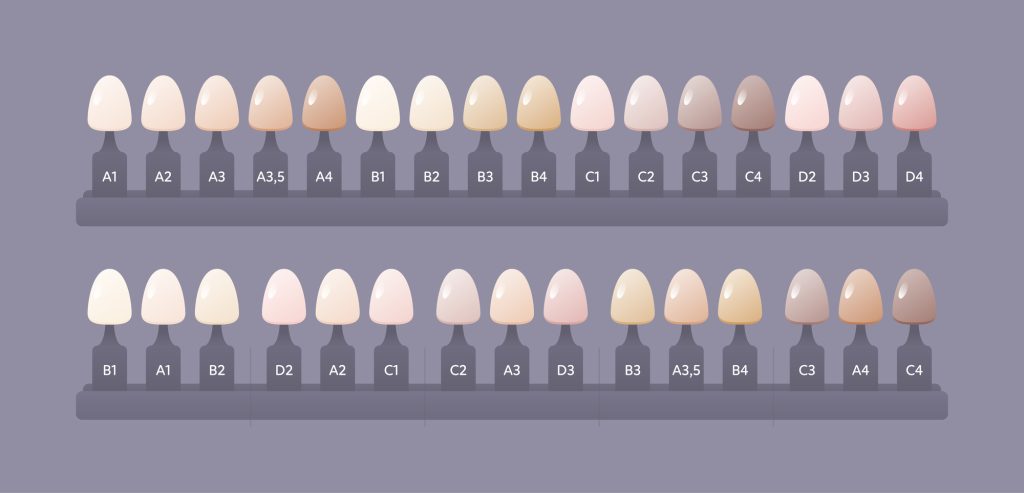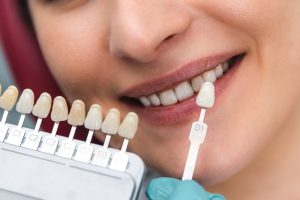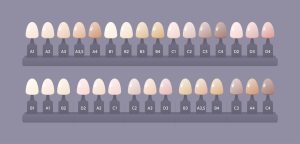Are you worried about the tooth shade your teeth reflect? Worry no more — Dentaly.org is here to help you with an explanation on the teeth coloring chart that dentists use!


In this article you will learn about:
- Natural or normal teeth color
- What the teeth shading chart dentists use is and what it means
- White, yellow, and brown teeth
- How you can improve your tooth colors and overall dental appearance
In talking about these elements of teeth colors, we hope to give you some reassurance about your teeth. If you find you’re dissatisfied with your teeth shade, you can consider whitening options and the other options mentioned below.
White teeth
When your teeth are white, it gives the appearance that you have a healthy smile and follow a good dental hygiene routine. But an impression is not the same as a fact. Because a whitening treatment might alter the color of your teeth, having white teeth does not necessarily imply that your smile is healthy. Teeth are not naturally Hollywood white.
Yellow teeth
What shade is the most common tooth color?
Yellow teeth are the most common color, and in fact, a strong, healthy smile is indicated by a light yellow color. Dentin is the yellowish layer of microscopic tubules beneath your enamel. It’s what connects to the dental nerve in each tooth. The color of your dentin is faintly visible because the enamel is practically translucent, giving your teeth a yellow color.
The yellow tint of your teeth, however, is likely to darken as you get older. Teeth can also turn a darker yellow color as a result of certain foods and drinks.
Brown teeth
If you have a brown tint to your teeth, it’s quite possible that you’ve been ingesting tannin-rich goods such as wine, black tea, or coffee.
Tannins are a category of bitter and astringent compounds that give foods and beverages their darker color. They can be found in wood, bark, leaves, and fruit. Natural tannins and staining characteristics can be found in foods including grapes, oak, cocoa, walnuts, and rhubarb.
Brown teeth can also be caused by the use of nicotine and tobacco products on a regular basis. Tartar development is also indicated by brown spots on your teeth (hardened plaque).
The VITA classical shade guide
The color of a person’s teeth is determined by genetics, environment, and lifestyle. For teeth whitening and cosmetic dental restorations like dental crowns, bridges, and veneers, dentists use dental shade guide reference tools.
Patients can choose their preferred teeth whitening results from teeth shades guides, and dentists can display patients before and after photographs of tooth shade changes.


What is the whitest shade of teeth?
Regardless of initial tooth color, the B1 teeth shade is guaranteed to deliver the whitest shade. Original tooth shade is divided into four primary shades, with a range of sixteen tones.
- Reddish-brownish : A1 – A2 – A3 – A3,5 – A4
- Reddish-yellowish : B1 – B2 – B3 – B4
- Greyish : C1 – C2 – C3 – C4
- Reddish-grey : D2 – D3 – D4
The shades are characterized by a letter — A, B, C, or D — and a number from the lightest, 1, to the darkest and most intense, 4. As a result, the A1 tooth shade will be a reddish-brown tone similar to shade A2 tooth color, but lighter.
Individuals may have one or more of these tooth colors, or they may fall into a certain dental range. A1, A2, A3, and A4 are examples of tones within the A shade. Transition hues are included in the teeth color chart to make it easier to identify tooth color tone that suits individual tooth shades.
Individuals can choose the teeth whitening shade they want by using the tooth color chart to identify their tooth shade.
Dentists evaluate shades from lightest to darkest when matching tooth color for teeth whitening, and they may change the order for the purpose of dental restorations. The beauty of this tooth shade guide reference tool is that teeth whitening outcomes may be monitored and analyzed, allowing for additional whitening to attain the desired shade.
The teeth coloring chart is used by dentists all over the world to determine initial tooth shade and progressive tooth shade as whitening results take effect. In-home teeth whitening kits and those delivered under dentist supervision frequently include teeth whitening charts.
How can I improve my dental appearance?
To modify the color of your teeth, you have a variety of options:
- Teeth whitening – Home remedies, professional whitening, at-home kits
- Maintain good oral hygiene – Brush twice a day for two minutes and floss every day
- Avoid staining foods that are acidic and sugary – Soda, coffee, tea, lemons, berries
- Quit smoking or using tobacco products
- Cosmetic dentistry – Dentures, veneers, and bonding
Visiting your dentist for in-office whitening or using an at-home professional whitening procedure can whiten your teeth by up to 8 shades and employs stronger, more powerful materials than over-the-counter whitening treatments. These treatments are safe for adults and teens to use. Although they aren’t permanent, they can help renew your smile.
Conclusion


Now you know how to determine if your teeth are healthy from our tooth shades chart. Having Hollywood white teeth does not make your teeth healthier but can be aesthetically pleasing. Based on the teeth coloring chart, are you happy with your tooth shades?
ADA.org: Whitening. Consulted 30th December, 2021.
VITA: Vita Shade Guides. Consulted 30th December, 2021.
Sparkle Dental: 50 Shades of White: How to Choose the Right Shade for Teeth Whitening. Consulted 30th December, 2021.




